Experimental engineering machine Appareil Boirault №2 (France)
Recall that the first draft of the preliminary engineering project Appareil Boirault (“Buaro Device”) appeared back in December 1914. The proposal of L. Buaro was to equip the perspective all-terrain vehicle with an original chassis, based on the idea of a tracked propulsion unit. Using large frames that perform the functions of tracks, such a machine had to literally push the wire barriers, making passages for its infantry. To increase the width of the aisle, the designer used an unusual layout of the machine with a large propeller size and a relatively small central unit that served as the hull with the power plant and the driver's cabin.
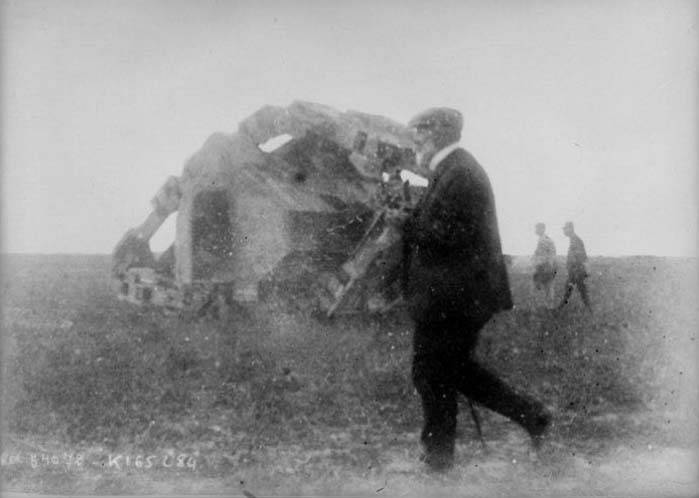
Prototype Appareil Boirault #2 on trial
The Appareil Boirault project was completed by the end of spring 1915 of the year. Engineering vehicle documentation submitted to the army. Experts of the armed forces got acquainted with it and made their decision. The proposed model could not have high speed and maneuverability, because of which further work on the project was considered impractical. Nevertheless, L. Bouarot was able to convince the military of the need to continue work and build an experienced all-terrain vehicle. After that, the project was corrected taking into account the comments of the military, and then the assembly of the prototype began.
A prototype of the Buaro Device was put to the test in early November of the same year. 4 and 13 in November were two stages of testing, during which the experimental machine showed its mobility and the ability to overcome various obstacles. The machine successfully overcame wire obstacles and crossed trenches with craters. However, the speed did not exceed 1,6 km / h. The real indicators of mobility and the absence of any protection of the crew or vital units led to the appropriate decision of the army. The French military refused to support further work, which should have resulted in the closure of the project. Later, the prototype, for some time left in storage, was disposed of as unnecessary.
The French army, having familiarized with the first prototype of the Appareil Boirault machine, refused to purchase such equipment. The military was not satisfied with low speed, unacceptably poor maneuverability and the absence of any protection. In addition, the first draft did not include the use of weapons. In its current form, the engineering machine had no prospects. However, the author of the original project did not give up and decided to continue the development of special military equipment. He took into account all the claims made and developed a new version of the all-terrain vehicle, more adapted for use in the army. The new project received the designation Appareil Boirault No. XXUMX - “Buaro device, the second”.
Despite all the claims of the military, L. Buaro found both the principle of movement itself and the original chassis architecture, as well as the machine as a whole, suitable for further use. The overall layout of the second “Device” should have been maintained, but the various units should have been modified in accordance with the updated requirements related to the possibility of operation in the army. It should be noted that it was not possible to manage with small alterations. In fact, the French inventor had to develop all the basic units from scratch, albeit based on the available solutions.
Machine Appareil Boirault №2 retained the design of the propeller, based on the ideas of the caterpillar. To navigate through various landscapes and combat the enemy’s non-explosive obstacles, a system consisting of six rectangular sections-frames was to be used. In the framework of the second project, L. Buaro made the most serious changes to the design of sections, which led to the appearance of products of other dimensions and modified form. In particular, over time, additional side stops-coulters appeared on the “track”.
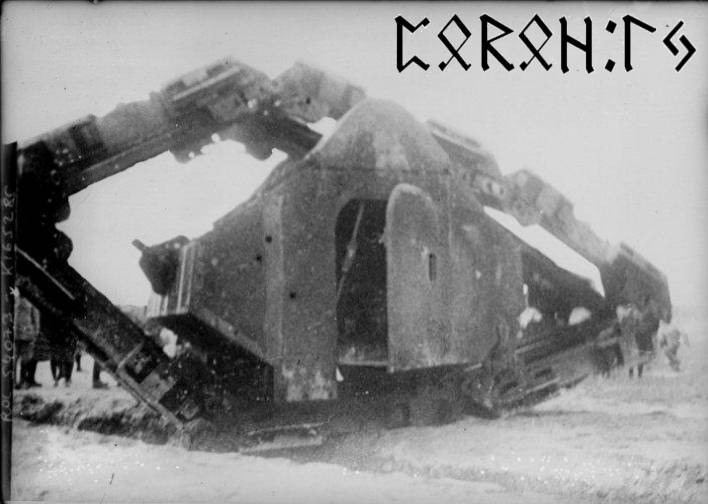
General view of the left side of the car
As in the first project, the basis of the propulsion section-frame was a quadrangular structure assembled from metal profiles and reinforced with kerchiefs at the corners. At the same time, unlike Appareil Boirault No. XXUMX, the new all-terrain vehicle had to have an additional longitudinal beam, which strengthens the frame. At the two ends of the frame in contact with other similar devices, hinge parts were located. The side beams were equipped with a set of stops, with the help of which the mutual movement of the two frames was limited. The design of the car was such that the angles between the frames had to remain within certain limits. Going beyond this range threatened the suspension of the chassis and the loss of travel.
On the inner surface of the frames, along the outer beams, rails passed. As in the previous project, the central unit of the machine, which accommodates the power unit and the driver, had to move along a closed rail track inside the propulsion unit. For this, it had a set of rollers, including those connected to the engine.
The first experimental model of the “Buaro Device” was equipped with a central unit, made on the basis of a frame of a triangular profile. This design allowed to equip the all-terrain vehicle with all the required devices, but it became a reason for criticism. The prototype had no protection, which is why, by definition, it could not be released on the battlefield. In the second draft, the inventor took into account the claims of the military, thanks to which the central unit received a reservation, and was also refined to reflect possible combat use.
Since the Appareil Boirault No. XXUMX machine, according to the creator's plan, was to be used by the army on the margins of the First World War, it had to be equipped with a full-fledged volume armored body, the dimensions of which allowed to place inside the power plant, transmission, crew of several people, as well as weapons and ammunition. The solution of such a task was to some extent hampered by the need to use the correct hull shape with a gable roof. A different structure of the upper part of the body could lead to the contact of the roof with the propulsion elements and their mutual damage.
The result of the design work has become a complex case, capable of accommodating all the necessary devices and people. The frontal part of the hull was made in the form of a complex multi-faceted design with three front sheets mounted at different angles to the vertical. On each side they were joined by two quadrilateral cheekbones, placed at an angle to the horizontal. Behind such a frontal unit was a rectangular main volume formed by two vertical sides and a horizontal bottom. In this part of the body there were two doors for access inside the car. The feed had some similarities with the front of the hull, but did not receive converging side plates. Instead, they used vertical parts, which are a continuation of the central side parts.
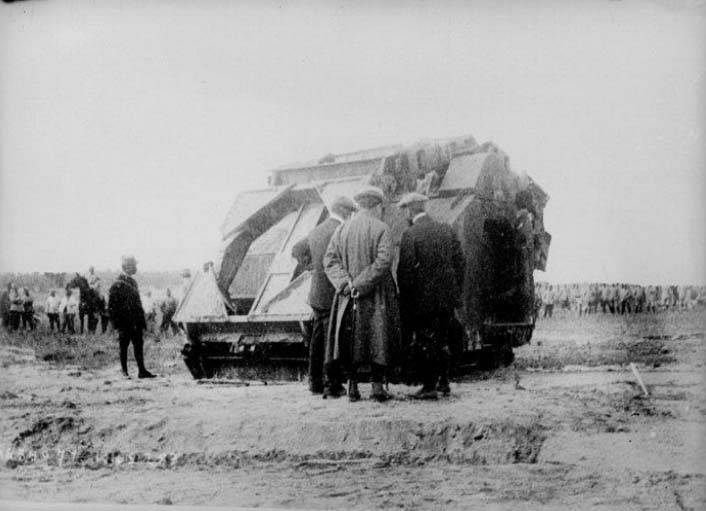
Prototype tests
Due to the use of inclined sheets of the forehead and stern, the necessary shape of the upper part of the body was formed, excluding its contact with the propulsion details. At the same time above the body were some parts of the transmission. For their protection over the sides, additional triangular-shaped covers with rounded upper corners appeared.
Inside the case there was a gasoline engine of the available type. The first version of the engineering machine was equipped with a 80-strong engine, while the power of the Appareil Boirault prototype powerplant No. XXUMX is unknown. The engine mated with a mechanical transmission, which included several gears and chains. With the help of the latter, the engine was connected to the driving wheels of the propeller. There were two leading axles with wheels: one was under the bottom of the case, the second - above its roof.
Chassis main unit all-terrain vehicle had a fairly simple design. Two axles were fixed to the bottom with rollers interacting with the propulsion rails. Another such axis was on the roof. It is known that some turning mechanisms were used as part of the undercarriage, but descriptions of their design were not preserved. In his first project, L. Buaro used jacks, braking one of the sides of the machine. It is unknown how it was proposed to maneuver the “Device” of the second model.
According to some reports, the engineering machine Appareil Boirault No. 2 was supposed to carry weapons for self-defense. In the central front and rear sheets of the hull were to be placed two installations for machine guns of the brand Schneider. According to other sources, machine guns should be mounted on installations in the side doors. It is noteworthy that in this case, the engineering machine received a certain similarity with the future early tanks British-developed weapons installed in sponsons.
Manage all-terrain vehicle was a crew of three. One of them should perform the functions of a driver, and the other two were arrows. For access to their seats, the crew were asked to use side doors. The crew could observe the terrain with a set of viewing slots in different parts of the armored hull.
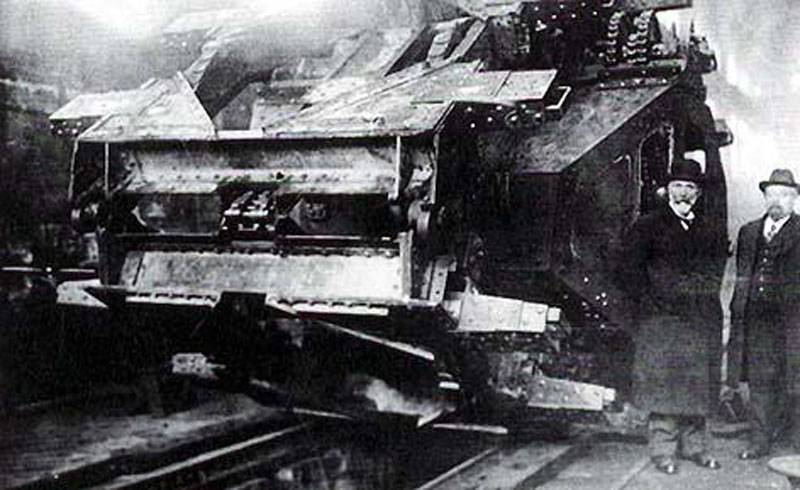
Engineering car after finalizing the chassis, front view
Despite the change in the design of the main units, the principle of operation of the original propulsion remained the same. With the engine running, the central unit-housing had to move along the rails of the propulsion sections and change their position. Moving forward, the central unit ran into the front section of the propulsion unit and made it fall. That, in turn, stretched forward the sections above the hull. Initially it was assumed that the use of six large and durable frames would allow high pressure wire or other barriers.
Louis Buaro continued to develop his ideas until about the middle of 1916, after which he managed to re-interest the army. By this time, the French command had learned about the development of promising armored vehicles in the UK and had also shown interest in such a technique. The new project Appareil Boirault №2 forced to recall the failure of last year, but still attracted the attention of a potential customer. Soon came the order of the military department to build a prototype of a new machine.
The prototype “Buaro Device #2” was built in the middle of summer 1916. In August, the car was sent to the landfill for inspections. As in the case of the previous project, the fate of the car was determined by the results of only two stages of inspections, each of which took one day. Inspections at the test site passed 17 and 20 on August 16. The first day was intended to determine the capabilities of the machine, and the purpose of the second was actually to demonstrate the original design to the representatives of the command.
To test the capabilities of the armored vehicle, a route simulating the battlefield was again prepared. On a relatively flat section of the landfill, wire fences were equipped, rail tracks were laid down, several trenches were dug out, and craters similar to those left after the explosions of the projectiles were made. During the 20 August demonstration, the prototype Appareil Boirault No.2 was able to cross the 1,5 km track in about an hour and a half. The original propulsion of the machine without any difficulty crumpled wire fences, then provided the intersection of trenches with a width of 1,8 m and funnels up to 2 m in diameter. The control system used for the course showed its efficiency, but its real characteristics were insufficient. The car turned very slowly, which is why the turning radius reached 100 m.
There is information about some modifications of the propeller at one of the stages of the project. In the tests used section frame in its original form, without additional equipment. In this case there are several photographs depicting Appareil Boirault №2 with a modified chassis. It should be noted that all of them were made in the workshop of the manufacturer. Exact information about the shooting time is not available. Apparently, after the first tests, it was decided to modify the original propulsion unit in order to slightly increase the parameters of the machine.
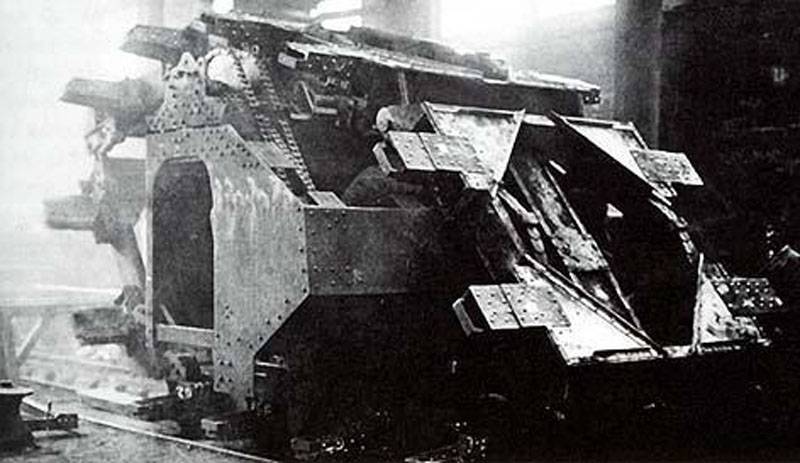
Improved prototype, view of the stern
All new improvements were to use additional stops, grouser. Rectangular details appeared on the reinforcing kerchiefs of the frame sections that extend beyond the original support surface. This could, to a certain extent, increase the footprint of the machine, improving its maneuverability and mobility. However, as can be judged from the data that has been preserved, such a variant of the engineering vehicle at the test site was not tested and did not go beyond the limits of the assembly shop.
The reason for the refusal to test the technology with an improved propeller were the results of the demonstration 20 August 1916 year. This event was attended by General Henri Joseph Eugene Gourette, familiarized himself with the original design and criticized it. The General acknowledged that the “Buaro Device No. 2” is capable of crushing everything in its path. But at the same time, he doubted the possibility of a proper exit to the intended goal. Low maneuverability dramatically reduced the actual fighting qualities of equipment. In addition, the general noted that the tests were not convincing, since the test track for testing machines very poorly reflects the realities of the front of the current war.
Tests of the second engineering machine by Louis Buarot again showed the efficiency of the structure, at the same time demonstrating its inadequacy for practical use. Criticism of the command has deprived the original development of any real prospects. The army did not want to order the proposed equipment and refused to help with the further development of the project. The designer was forced to stop work. Like its predecessor, the prototype Appareil Boirault No. XXUMX was sent to storage. In the future, the machine that was no longer needed was sent for disassembly. Until our time, none of the prototypes of the original technology did not live.
After the second rejection of the military department, L. Buaro ceased working on the development of the original propulsion device, capable of overcoming various obstacles and literally pushing down enemy barriers. However, he has not lost interest in armored vehicles in general. In the future, the inventor proposed several options for unusual tanks of complex architecture, which used the existing models of armored vehicles and some new equipment. These projects were unsuccessful even in comparison with Appareil Boirault. For several reasons, they could not even reach the stage of building prototypes.
On the materials of the sites:
http://aviarmor.net/
http://landships.info/
http://g1886.com/
http://network54.com/
http://shushpanzer-ru.livejournal.com/
Information